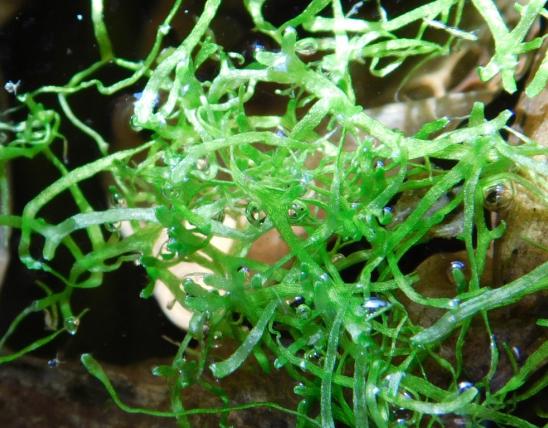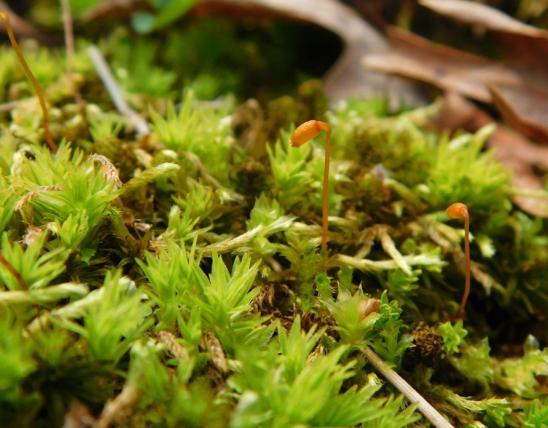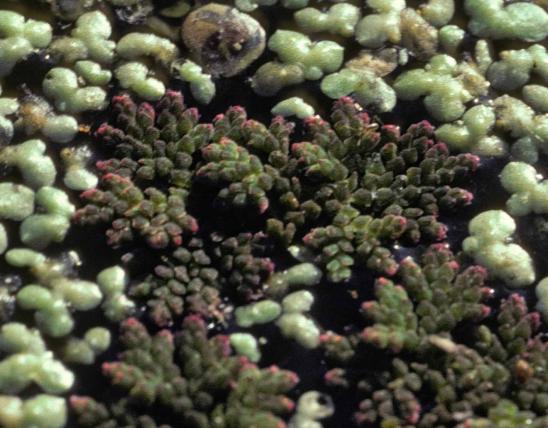
Liverworts, like mosses, are land plants that do not have a vascular system. The lack of veinlike tubes to conduct moisture and nutrients throughout the plant limits them to a small size. Like ferns, they produce spores instead of seeds. Their form of reproduction usually requires them to be in wet or moist places.
Also like mosses, liverworts do not have true leaves, stems, and roots — at least not in the same sense as in vascular plants. But for simplicity’s sake, we tend to use these familiar terms instead of “leaflike structure,” “stemlike structure,” and “rhizoids.”
The liverworts fall into two groups based on their growth form:
- The thalloid or thallose liverworts look like green ribbons or scales that grow flat against a surface. This part of the plant is called the thallus. If the thallus branches, it does so in a Y-shaped pattern. There are no clearly defined stems or leaves.
- The leafy or scaly liverworts are much less familiar to people. They may resemble mosses or very tiny ferns. They have flattened stems with small, rounded, overlapping, leaflike scales in at least 2 rows; the stems often produce side branches.
The reproductive structures are usually important for identification. Those of the leafy liverworts are obscure, variable, and hard for an amateur botanist to see. Most of the thalloid liverworts, however, have obvious reproductive structures. First are the gemmae cups, which often grow directly on the surface of the thallus and resemble small, open cups. These contain vegetative reproductive fragments called gemmae. See Life Cycle below for how this works.
The male and female reproductive organs of thallose liverworts usually occur on different plants. The female reproductive structures are often stalked, arise from under the thallus, and have a lobed cap upon maturity. Depending on species or their stage of development, they may resemble small umbrellas, palm trees, or capped mushrooms. These female reproductive structures are called archegonia. The male reproductive structures may resemble a wart or they may have a tall, stalked appearance. These are called antheridia. Again, see Life Cycle below for how this works.
In most cases, it’s easy to distinguish liverworts from mosses, but there are several key differences that can help you separate them:
- The leaves of leafy liverworts grow in two distinct rows, one row along each side of the stem, facing upward; there is often a third row, quite different and less noticeable, on the underside of the stem; these are called underleaves. Meanwhile, the leaves of mosses are attached all around the stem.
- The leaves of liverworts do not have a midrib, while the leaves of many mosses do have a midrib.
- The leaves of leafy liverworts are often lobed or notched at the tip, but while moss leaves may be toothed, they are never lobed or notched.
- Liverwort reproductive structures are short-lived, while the capsules of mosses may last for weeks or months.
- The rhizoids (rootlike structures) of liverworts are single-celled, while those of mosses have more than one cell (you’ll need a microscope to see this, however).
Separating the species of liverworts can be difficult even for botanists. You often must have the plant’s reproductive structures, plus a microscope or at least a hand lens, as well as a good grasp of some specialized terminology. Identification, for example, may use descriptions of the reproductive structures or even the spores. Examining spores requires a microscope. Other characters include the shape, margins, and unique overlapping pattern of a liverwort’s tiny leaves.
This page is an introduction to Missouri’s liverworts. Below are some common and widespread species.
Thallose liverworts
- Snakeskin liverwort (Conocephalum salebrosum; formerly called C. conicum in North America) occurs on very moist soil or rocks, in rather shady areas, often in the splash zone of creeks. Thallus is in the form of large, flattened, irregular, overlapping straps. The surface is covered with air pores, giving it a bubbly appearance similar to snakeskin. The antheridia are fairly obscure and look like warty spots on the thallus. The archegonia are quite noticeable, resembling small mushrooms with conical heads (Conocephalum means conehead). These structures are supported on a light green, watery stalk and are short-lived. Antheridia usually shed sperm in autumn; archegonia arise on stalks the following spring.
- Umbrella liverwort (Marchantia polymorpha) is similar to the above, but the thallus turns up at the edges; the netlike pattern on the upper surface is less deeply indented and less noticeable; it commonly has cuplike gemmae on the upper surface; the antheridia are stalked, with a flat, circular top with lobed or deeply scalloped edges (not sessile and wartlike). The archegonia, at first, look like small mushrooms, but at maturity they open to produce fingerlike projections radiating from the central stalk (looking like tiny palm trees). In addition to damp, shady areas in nature, it is also fairly common in gardens and greenhouses.
- Hemispheric or purple-fringed liverwort (Reboulia hemisphaerica) occurs on soil or rocks. The thallus consists of many small, rounded lobes that are slightly cupped like shallow bowls. When the plant dries, these lobes may curl upward considerably. The margins of the thallus are somewhat rough and purplish. Unlike the two above, the surface of this liverwort is fairly smooth with very tiny air pores. The archegonium looks like a stalked umbrella with hairlike scales at the top of the stalk, under the cap. Unlike the above two, this species is monoecious (producing both male and female reproductive structures on the same plant).
- Floating crystalwort, or slender riccia (Riccia fluitans) floats in lakes, ponds, and streams, forming dense, tangled mats in shallow water. This is a thalloid liverwort, but it hardly resembles its relatively large, fleshy relatives. The thallus is long, slender, and flat. It branches profusely, with each branch ending in a notch. Occurs globally. Used by aquarists, especially in breeding tanks where it provides cover for young fry. Nearly 20 species of Riccia have been recorded for Missouri, but this — one of the few floating species — is most common and widespread.
Leafy liverworts
- Frullanias, or scaleworts (Frullania spp.), are a large group of leafy liverworts, with 8 species in Missouri. Three, F. eboracensis, F. inflata, and F. riparia, are some of our most widely distributed liverworts, but they are overlooked by most people. Frullanias typically grow flat against the bark of trees and shrubs (F. riparia on rocks) or on dead trees, often in a branching pattern, forming traceries. In many species, the overall spread may be only about 4 inches in diameter. Many frullanias are dark olive green, brownish, reddish, or purplish. The round leaves lie in 2 alternate rows, have no midribs, and typically overlap each other. Minute helmet-shaped leaf appendages can store water and help these tiny plants survive relatively dry situations.
- Variable-leaved crestwort (Chiloscyphus profundus; syn. Lophocolea heterophylla) is another common Missouri leafy liverwort. It is one of at least 9 species in its genus in Missouri. It has translucent, yellowish-green leaves growing on opposite sides of the stem. At the base, the older leaves have 2 lobes, while at the tip, the leaves may be smooth; in between, the leaves are merely notched. The pointed leaf tips give this liverwort a shaggy appearance overall. It is common on moist, rotting, barkless logs lying on the ground, usually near water. It looks mosslike, but mosses don’t have leaves in two rows like this.
- Porellas (Porella spp.) are rather large and vigorous for liverworts. Three species occur in Missouri: P. pinnata, P. platyphylla, and P. platyphylloidea. They are leafy and have numerous branches, giving them a crowded, matlike appearance. They grow flat against the trees or rocks they live on. The leaves are rounded, alternate, and arranged in two rows along the stem. Porellas are often brighter green than frullanias. In P. pinnata, the leaves are small and barely touch, while those of P. platyphylloidea are larger, more crowded, and overlap, giving it the gathered appearance of a raised curtain. As with crestworts, these mossy-looking liverworts have leaves in two rows, distinguishing them from true mosses.
Similar species: Several organisms can be mistaken for liverworts, especially since some liverworts might be mistaken for mosses! Here are some lookalikes.
- Missouri has 4 species of hornworts (division Anthocerotophyta) that might be mistaken for liverworts or mosses. Hornworts are named for their horn-shaped sporophytes (reproductive structures). Except for the pointed, rather thickened sporophyte, the body of the plant (the gametophyte) resembles liverworts or mosses. (These are not the same as the hornwort, also called coon's tail, that is so common as a submerged plant in lakes and other aquatic habitats; it is a vascular plant.)
- Certain lichens have forms similar to liverworts, especially to some of the leafy liverworts. Lichens are composite organisms formed from specific combinations of fungi and algae. They have a drier texture than liverworts and lack the specific anatomy mentioned above.
- Clubmosses (lycopodiums, family Lycopodiaceae, including ground pine) and spikemosses (selaginellas, family Selaginellaceae) are small, primitive vascular plants and are not frequently found in Missouri. They have rootlike rhizomes similar to those found on ferns. They resemble tiny conifer trees or large mosses.
Height: Most liverworts only cover an area a few inches wide, but some of the thallose liverworts can form large colonies on rocks along streams or in greenhouses.
Statewide. Different species can have different habitats and distributions.
Habitat and Conservation
Liverworts, like mosses and ferns, usually occur in moist or wet, cool, shady places such as along stream banks, on the terraces above streams, cool valleys on the north sides of slopes, and so on. They usually grow on a solid surface such as rocks or tree trunks, usually close to the ground. Certain species are associated with particular substrates and habitats.
Missouri’s liverworts and other bryophytes are understudied, mainly because they’re so small, and identifying them to species can be tedious. Their distribution in the state is poorly known, because certain parts of the state have been more thoroughly studied than others.
There are about 7,500–9,000 species of liverworts worldwide.
Status
Taxonomically, liverworts (division Marchantiophyta), mosses (division Bryophyta), and hornworts (division Anthocerotophyta) are grouped together informally as so-called bryophytes, or nonvascular land plants. Although they share many characteristics, and all have ancient lineages and are considered “primitive” (ancestral) plants, they do not represent a single branch of a taxonomic tree (they are paraphyletic), so their grouping is informal.
Previously, before DNA analysis showed they were not closely related, the three divisions were all considered as a single division, the Bryophyta. This is why they are still called bryophytes (with a little b) today.
Life Cycle
The liverworts we usually see are only one part of a two-part life cycle. This conspicuous part of the cycle, called the gametophyte (gamete-bearing plant), produces sexual reproductive structures: sperm-bearing male structures called antheridia (singular antheridium) and egg-bearing female structures called archegonia (singular archegonium). In most liverworts, the antheridia and archegonia occur on separate plants. Also, the sperm are not enclosed in pollen grains; they must swim through water to reach the archegonia.
The united sperm and egg develop into the second part of the life cycle, the sporophyte (spore-producing plant). The sporophyte is diploid: it has twice the genetic material as the gametophyte, since it has a copy from each parent. The sporophyte develops within the archegonium and eventually pushes beyond it. The sporophyte has a capsule in which spores develop; these spores each contain only one set of genetic material (half the genetic material of the sporophyte). When the sporophyte is mature, it sheds spores into the environment to develop into new gametophytes.
Asexual, or vegetative reproduction is very common in liverworts. As the gametophyte grows and branches, older parts die off and the branches continue as new plants. They can easily grow by cuttings, too. Floods can distribute fragments of liverworts downstream, creating new colonies.
The gemmae cups common in umbrella liverwort (Marchantia sp.) are another form of asexual reproduction. Gemmae can be thought of as tiny buds of the parent plant that separate to become new plants. In umbrella liverwort, the gemmae look like tiny leaves inside the cup. When rain strikes the gemmae cups, it splashes the gemmae away to begin new plants.
Human Connections
Globally, some liverworts have been used medicinally. The names “liverwort” and “hepatic” both refer to an antique belief that they could be used to treat liver ailments. This was based on an idea called the Doctrine of Signatures, which started in Classical Greek and Roman days and continued in Europe into the 1600s. The idea was that God marked everything on earth with a sign (signature) that gives a hint to its purpose for humanity; therefore, if something resembled a lung, it could be used to heal lungs, and certain types of thallose liverworts, which supposedly look like a liver, could treat liver problems. In the 1700s, the rise of humanism and the scientific method helped arrest this unsound reasoning.
Who cares about such tiny plants, when it takes so much work to identify them, and you have to learn so many new terms? It’s human nature to distinguish between things, and to apply names to them. It’s one of the first tasks humans did in the Bible, and it’s a basic survival skill among hunter-gatherer people. Children take to it naturally, and most of us like to “geek out” about something.
Now is a great time to learn about liverworts and mosses, because there is so much information available online. Before the Internet, you needed access to heavy reference manuals and scholarly journals, whose pictures were limited by publishers’ budgets. Today, photographs abound, and information is available at all skill levels.
Ecosystem Connections
Liverworts, mosses, and lichens gradually break down rocks and create soils, adding organic material and nutrients. Even in completely barren places covered only with rocks, they can be the first colonizers, changing the environment for other plants and animals to survive.
In some species, insects and springtails may help to distribute spores to new locations. Other animals such as shrews and mice may also move the spores around.
In spring, many birds hunt woodlands for soft, fibrous nesting materials, and liverworts and mosses are certainly among those used. Prothonotary warblers have been recorded using leafy liverworts in nest construction.
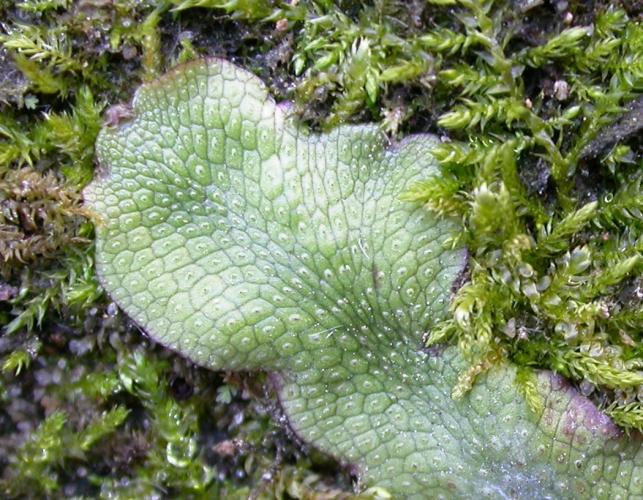







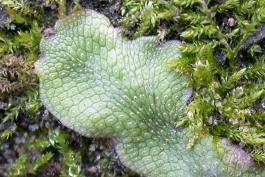







Mosses, liverworts, hornworts, and lichens seem rather similar, but these organisms are in very different groups. Mosses, liverworts, and hornworts are small, low plants usually found in damp habitats. Unlike more familiar plants, they lack veinlike structures and do not produce flowers or seeds — instead, they produce spores. Meanwhile, lichens are not plants at all: they are a collection of different fungi that have photosynthetic algae living within their tissues.


























